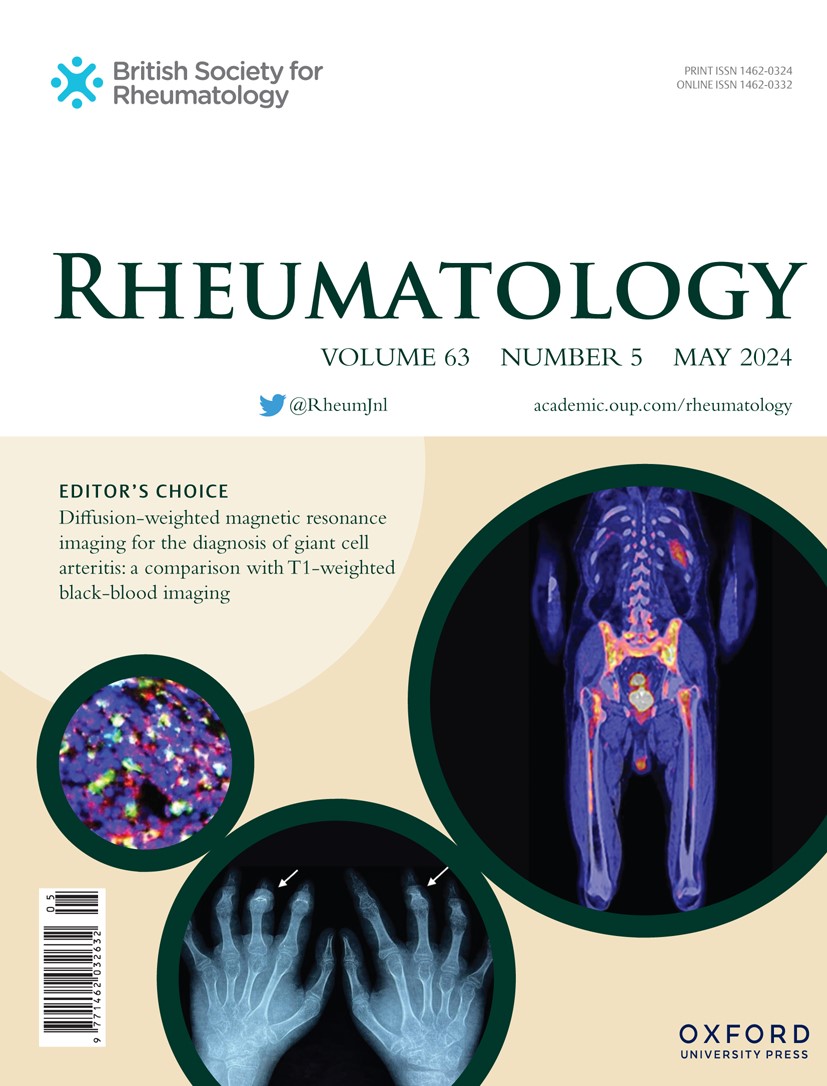P116 Is physical activity associated with central sensitisation indices or pain in rheumatoid arthritis?
IF 4.7
2区 医学
Q1 RHEUMATOLOGY
引用次数: 0
Abstract
Background/Aims Rheumatoid arthritis (RA) is a chronic condition where pain often persists despite controlled inflammation. Central sensitisation (CS), characterised by an amplified response of the central nervous system to nociceptive inputs, drives this persistent pain. While physical activity is important for health, its effectiveness in reducing pain and CS in RA is unclear. This study investigates whether self-reported physical activity levels influence pain and CS indices. Methods Ninety-two participants with RA from the Central Aspects of Pain in RA (CAP-RA) cohort completed the International Physical Activity Questionnaire (IPAQ) at baseline, categorising physical activity levels as Low, Moderate, or High. Quantitative Sensory Testing (QST) modalities, including pressure pain thresholds (PPT), temporal summation (TS), and conditioned pain modulation (CPM) were used as CS indices. Pain severity was the sum of 3 numerical rating scales (NRS) from the painDETECT questionnaire. Disease activity was assessed using the Disease Activity Score 28 (DAS28). Sixty-four participants provided 3-month follow-up data. Spearman’s correlations and multivariable linear regressions explored associations between physical activity, CS indices, and pain at baseline and over time. Results The median age of participants was 65 (range: 30,85) years. The majority were female (87%). Participants reported moderate pain, with a median pain severity score of 20 (IQR 16, 23) out of 30, and moderate disease activity (median DAS28: 4.5 [IQR 3.8,5.2]). DAS28 decreased by a median of -0.14 (IQR -1.1,+0.7), and median CRP decreased from 5.0 mg/L (IQR 2.0,8.0) to 4.5 mg/L (IQR 2.0,7.0) from baseline to follow-up. About half (54%) reported low physical activity levels, with no significant group change in physical activity from baseline to follow-up. However, 46% of participants transitioned between activity categories, indicating some movement in physical activity levels. Bivariate correlations revealed no significant associations between baseline physical activity and CS indices or pain, nor between change in physical activity and change in CS indices or pain. Multivariable linear regression showed that increases in CS indices and pain severity were most strongly predicted by their baseline values (β = range -1.05 to -0.25, all p < 0.05), but not by physical activity levels. Additionally, male sex significantly predicted increased TS (pain sensitivity) (β = 1.28 ,p =0.01), and high baseline swollen joint count was a significant predictor for increased pain severity after 3 months (β = 0.31, p = 0.02). Conclusion These findings indicate that people with RA who are more physically active do not tend to have lower pain sensitivity or pain, either at baseline or over time. Other factors, such as sex and inflammation, might have a greater impact on CS and pain than physical activity. This highlights the need for tailored interventions that effectively target central pain mechanisms to improve pain management in RA, over and above advice to increase physical activity. Disclosure A.A. Ibrahim: None. S. Smith: None. V. Georgopoulos: None. D. McWilliams: Grants/research support; DM-grant support from Pfizer and Eli Lilly. D.A. Walsh: Consultancies; Since 2015 he has undertaken consultancy through the University of Nottingham to AbbVie Ltd, Pfizer Ltd, Eli Lilly and Company, Love Productions, Reckitt Benckiser Health Limited and GSK (each non-pe). Honoraria; he has received speaker fees from the Irish Society for Rheumatology (personal pecuniary). Grants/research support; he has been responsible for research funded by Pfizer, Eli Lilly, UCB Pharma (non-personal, pecuniary); he receives salary from the University of Nottingham, who have received funding for that purpose. Other; he has contributed to educational materials via the University of Nottingham, supported by Medscape Education, New York, International Association for the Study of Pain, and Osteoarthritis Research.P116体育活动与类风湿关节炎的中枢致敏指数或疼痛有关吗?
背景/目的类风湿关节炎(RA)是一种慢性疾病,尽管炎症得到控制,但疼痛往往持续存在。中枢致敏(CS),以中枢神经系统对伤害性输入的放大反应为特征,驱动这种持续的疼痛。虽然体育活动对健康很重要,但其在减轻RA疼痛和CS方面的有效性尚不清楚。本研究探讨自我报告的身体活动水平是否影响疼痛和CS指数。方法92名RA患者在基线时完成国际体力活动问卷(IPAQ),将体力活动水平分为低、中、高。定量感觉测试(QST)方式,包括压力疼痛阈值(PPT)、时间总和(TS)和条件疼痛调节(CPM)作为CS指标。疼痛严重程度为painDETECT问卷中3个数值评定量表(NRS)的总和。使用疾病活动评分28 (DAS28)评估疾病活动。64名参与者提供了3个月的随访数据。Spearman相关和多变量线性回归探讨了体力活动、CS指数和疼痛在基线和随时间变化之间的关系。结果参与者的中位年龄为65岁(范围:30岁、85岁)。大多数是女性(87%)。参与者报告中度疼痛,疼痛严重程度评分中位数为20 (IQR为16,23),疾病活动性中等(中位数DAS28: 4.5 [IQR为3.8,5.2])。DAS28中位数下降-0.14 (IQR -1.1,+0.7),中位数CRP从基线至随访期间从5.0 mg/L (IQR 2.0,8.0)降至4.5 mg/L (IQR 2.0,7.0)。大约一半(54%)的人报告身体活动水平较低,从基线到随访期间,各组的身体活动没有显著变化。然而,46%的参与者在不同的活动类别之间转换,这表明身体活动水平有所变化。双变量相关性显示,基线体力活动与CS指数或疼痛之间无显著相关性,体力活动变化与CS指数或疼痛变化之间也无显著相关性。多变量线性回归显示,CS指数和疼痛严重程度的增加与基线值最能预测(β =范围为-1.05至-0.25,p <;0.05),但与体力活动水平无关。此外,男性显著预测TS(疼痛敏感性)增加(β = 1.28,p =0.01),高基线肿胀关节计数是3个月后疼痛严重程度增加的显著预测因子(β = 0.31, p = 0.02)。结论:这些发现表明,无论是在基线还是随着时间的推移,体力活动较多的类风湿性关节炎患者的疼痛敏感性或疼痛程度都不会降低。其他因素,如性和炎症,可能比体育活动对CS和疼痛的影响更大。这突出表明,除了建议增加身体活动之外,还需要针对中枢疼痛机制进行量身定制的干预措施,以改善RA的疼痛管理。A.A.易卜拉欣:没有。史密斯:没有。V.乔治普洛斯:没有。D. McWilliams:资助/研究支持;辉瑞公司和礼来公司的dm基金支持。沃尔什:咨询公司;自2015年以来,他通过诺丁汉大学向AbbVie Ltd, Pfizer Ltd, Eli Lilly and Company, Love Productions, Reckitt Benckiser Health Limited和GSK(均为非pe)提供咨询服务。酬金;他收到了爱尔兰风湿病学会的演讲费(个人收入)。授予/研究支持;他一直负责辉瑞,礼来,UCB制药(非个人,金钱)资助的研究;他的薪水来自诺丁汉大学,该大学为此目的获得了资助。其他;他通过诺丁汉大学提供了教育材料,并得到了纽约Medscape教育、国际疼痛研究协会和骨关节炎研究的支持。
本文章由计算机程序翻译,如有差异,请以英文原文为准。
求助全文
约1分钟内获得全文
求助全文
来源期刊

Rheumatology
医学-风湿病学
CiteScore
9.40
自引率
7.30%
发文量
1091
审稿时长
2 months
期刊介绍:
Rheumatology strives to support research and discovery by publishing the highest quality original scientific papers with a focus on basic, clinical and translational research. The journal’s subject areas cover a wide range of paediatric and adult rheumatological conditions from an international perspective. It is an official journal of the British Society for Rheumatology, published by Oxford University Press.
Rheumatology publishes original articles, reviews, editorials, guidelines, concise reports, meta-analyses, original case reports, clinical vignettes, letters and matters arising from published material. The journal takes pride in serving the global rheumatology community, with a focus on high societal impact in the form of podcasts, videos and extended social media presence, and utilizing metrics such as Altmetric. Keep up to date by following the journal on Twitter @RheumJnl.
 求助内容:
求助内容: 应助结果提醒方式:
应助结果提醒方式:


